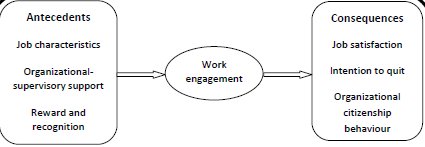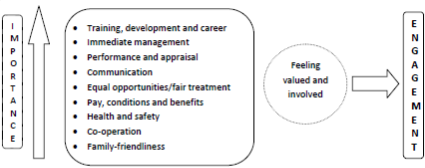Introduction
Many companies implement various strategies that are geared towards boosting their success. For instance, some engage in establishing a culture or an atmosphere that is in tandem with their mission and vision while others emphasize the need for engaging their workers who are regarded as crucial assets that have the potential of turning companies into global giants. Google LLC, which forms the basis of discussion in this report, is an international organization located in Mountain View, California. The company’s mission is to supply consistent, timely, and worthy information to users from all over the world. Hence, following the key role that the concept of employee engagement is perceived to play in influencing organizational performance, this report aims to develop a critical understanding of contemporary factors required for leading and managing employees efficiently for continued organizational economic performance, competitiveness, and success. The objective is to find out the link between workers’ level of engagement and organizational performance. From the findings, this report will recommend mechanisms that the chosen company can deploy to change the prevailing levels of employee engagement and, consequently, organizational productivity.
Literature Review
The Concept of Employee Engagement
According to Boddy (2016), the need for continued profitability and business sustainability in today’s competitive world has forced many organizations to review their practices. For instance, the last few decades have been marked by companies’ heightened emphasis on culture transformation, including a change in the manner they handle or value their human resources. According to Padhi and Panda (2015), Saks’ conceptual framework on employee engagement (see Figure 1) offers a better starting point. The model reveals the outcomes that organizations may record when they provide or fail to avail of various elements that constitute employee engagement.

Organizations around the globe are currently assessing the role of workers in enhancing their continued achievements. Varied opinions that arise in many forms, including a mention of culture change, remuneration packages, and work-life balance imply that indeed companies view employee engagement from diverse perspectives (Phelps 2016). Allen (2014) presents workplace engagement as the emotional dedication that human resources express towards their companies, including the measures they adopt to guarantee institutional success. For example, Apple’s appreciation of the invaluable input of engaged workers forced it to adopt the 360o-engagement strategy that embraces the link between zealous workers, client attraction and retention, and, subsequently, organizational performance (Madan 2017; Boddy 2016).
In my judgment, Allen’s (2014) definition of the concept under investigation is detailed because it captures elements that engaged workers display in a company. For instance, his view of employee engagement emphasizes the aspect of emotional devotion that is comprised of components such as care, allegiance, passion responsibility, and results from delivery (Allen 2014). Jindal, Shaikh, and Shashank (2017) present an analogous perception of the concept, although their view is focused on the organization, as opposed to workers. In this case, the authors depict employee engagement as the strategies that a company establishes to create a culture whereby its human resources always wish to go the extra mile to deliver their mandates in line with the set goals and objectives. Padhi and Panda’s (2015) conceptual employee engagement framework (see Figure 2) is a combination of Allen (2014) and Jindal, Shaikh, and Shashank’s (2017) definitions of the concept.

The above model points to the mutual positions that companies and their workers hold in enhancing employee engagement. Consequently, the HR department is tasked with ensuring that workers are fully engaged and that the respective organization avails the necessary support to facilitate the achievement of this goal (Jindal, Shaikh & Shashank 2017). For example, the HR unit at General Electric (GE) has ensured that the company’s EcoAwards initiative that forms part of its employee engagement efforts is executed consistently for at least five years (Condon & Holdredge 2017). Such campaigns have enhanced employees’ commitment towards realizing the company’s goal of decreasing the levels of harmful gasses that have been released into the atmosphere to the extent of ruining the environment through global warming. Other authors define employee engagement as “the sense of purpose” (Simpson 2016, p. 1) expressed by the workforce towards a company’s mission.
It is crucial to note that the above diverse views regarding the concept of employee engagement are designed in a manner that matches particular companies’ specifications. Hence, although the available literature presents a general view of what employee engagement involves, the existence of distinct cultures that define the operations of particular companies implies the need for organizations to tailor their employee engagement strategies to reflect their mission and vision statements (Boddy 2016). According to Phelps (2016), employee engagement does not occur by chance. It follows a series of consistent efforts such as culture customization and structural modifications that companies put in place to maximize employees’ input while ensuring that they feel as crucial assets that keep them (organizations) operational and reputable. As will be revealed in the next section, organizations that implement employee engagement programs are driven by the desire to attain higher performance.
Discussion
The Relationship between Employee Engagement and Google’s Performance
Allen (2014) reveals that indeed employee engagement has a substantial bearing on a company’s performance, profitability, and, consequently, competitive advantage. Google appreciates the critical role of workers in realizing this goal. The company is ranked among the top-performing businesses in the world (Phelps 2016). Workers from different sectors agree that Google has one of the best working environments. Such a workplace setting encourages the company’s workforce to remain engaged and focused on its mission and vision of availing consistent and valuable information to the global population. Google has demonstrated that everything good in a company comes at a cost.
The organization is the international leader in terms of the expenses it incurs for the sake of its employees. In my opinion, the company’s recognition of an employee even after their passing away by extending decade-long financial support to their survivors is among the key elements that drive employee engagement and competitiveness in the organization. Such a notch-higher acknowledgment of the value of a worker, whether living or dead, places Google at the top-most position globally regarding its extent of implementing employee engagement strategies and, consequently, the reason why it is still the world leader in terms of performance. Consequently, in this report, it is imperative to examine the link between the levels of employee engagement and the organization’s performance, productivity, and competitive advantage.
The study by Jindal, Shaikh, and Shashank (2017) reveals that organizations, which acknowledge the need for maintaining high levels of workers’ engagement, usually record exemplary performance and profitability. However, in my opinion, the research has the limitation of failing to specify what “high-level performance” entails. The authors needed to include specific elements that constitute high and low-level performance to help interested companies such as Google to gauge the extent to which they have implemented their employee engagement strategies.
According to Simpson (2016, p. 1), “Increased levels of engagement lead to better organizational performance”. The author’s research seals the gap identified in Jindal, Shaikh, and Shashank’s (2017) study because it introduces a model, namely, Employee Engagement Index, which other organizations can use to assess their degree of investing in this concept. It also includes universal elements such as workers’ perceptions of their companies’ bosses that constitute employee engagement. Consequently, with the help of the framework, Google has managed to determine areas that need improvement to attain the required engagement levels. The company’s competitive advantage is linked to its employee wellness, nutrition, training and development, and even health schemes among others, which it has initiated to keep its employees engaged and committed to its mission.
Nonetheless, the article by Jindal, Shaikh, and Shashank (2017) confirms the existence of a connection between workers’ engagement, client devotion, and institutional profitability. Google has realized the impact that a welcoming environment has on its employee engagement levels. According to Phelps (2016), the company’s efforts to implement employee-focused programs are founded on its motto of evading immoral actions because they hinder business productivity. In particular, the company’s Chief People Manager, Laszlo Bock, was quoted saying, “It turns out that the reason we’re doing these things for employees is not that it’s important to the business, but simply because it’s the right thing to do” (Phelps 2016, para. 3). Hence, in line with Mishra, Sharma, and Bhaskar’s (2015) observations, Google’s employee engagement strategies have boosted its competitive advantage and, consequently, it is global standing.
Conclusions and Recommendations
Regarding the objectives raised earlier in this report, it is confirmed that employee engagement is a crucial approach that contemporary companies are emphasizing to enhance their performance and productivity levels. The models discussed concerning the concept of employee engagement suggest the central role that employees and employers play in achieving the above goal. Nonetheless, from this research, one learns that organizations cannot attain the recommended employee engagement levels if they are not ready to invest massively in their workers who are key assets that drive their (organizations) profitability and performance agendas.
However, the findings from Saks’ framework indicate the consequences that companies may incur if they fail to implement appropriate employee engagement initiatives. Although the company has been consistent and effective in executing employee engagement programs to the extent of being ranked among the top-performing organizations globally, it is not prone to the above consequences. This claim is based on the recent turnover witnessed in 2009 whereby some of its key employees such as Elliot Schrage relocated to the company’s rival, Facebook. Additional 100 workers were retrenched during the same year. Hence, as a way forward, the company may need to:
- Upgrade its current HR system that may be interrupting its employees’ engagement levels, especially the continuous hiring of new workers. By reducing the tension that piles up among the existing labor force when new workers are hired, the company may witness an improved performance.
- Revise its remuneration packages to seal gaps that may have informed top workers to opt for quitting to other organizations. Such a move will ensure that it always enjoys the services of its highly valued managers.
- Establish a particular limit of employees or a particular timeframe that should lapse before hiring new workers. This strategy will not only cut its recruitment costs but will also ensure that the company has more time enhancing the experience and, consequently, the productivity of its existing pool of employees.
Reference List
Allen, M 2014, Employee engagement – A culture change, Web.
Boddy, D 2016, Management: an introduction, 7th edn, Pearson, London.
Condon, A & Holdredge, P 2017, 5 ways companies can weave sustainability into their DNA, Web.
Jindal, P, Shaikh, M & Shashank, G 2017, ‘Employee engagement; tool of talent retention: study of a pharmaceutical company’, SDMIMD Journal of Management, vol. 8, no. 2, pp. 7-16.
Madan, S 2017, ‘Moving from employee satisfaction to employee engagement’, International Journal of Research in Commerce & Management, vol. 8, no. 6, pp. 46-50.
Mishra, B, Sharma, B & Bhaskar, A 2015, ‘Predictors of employee engagement: the case of an Indian PSU’, The Indian Journal of Industrial Relations, vol. 50, no. 3, pp. 469-478.
Padhi, B & Panda, A 2015, ‘A study on employee engagement models for sustainability of organisation’, International Journal of Research and Development – A Management Review, vol. 4, no. 4, pp. 79-85.
Phelps, S 2016, ‘Learning from Google: 15 ways to drive employee engagement’, Purple Goldfish, Web.
Simpson, H (ed) 2016, Federal employee engagement and performance: trends, drivers, and value of outcomes, Nova Science Publishers, New York, NY.